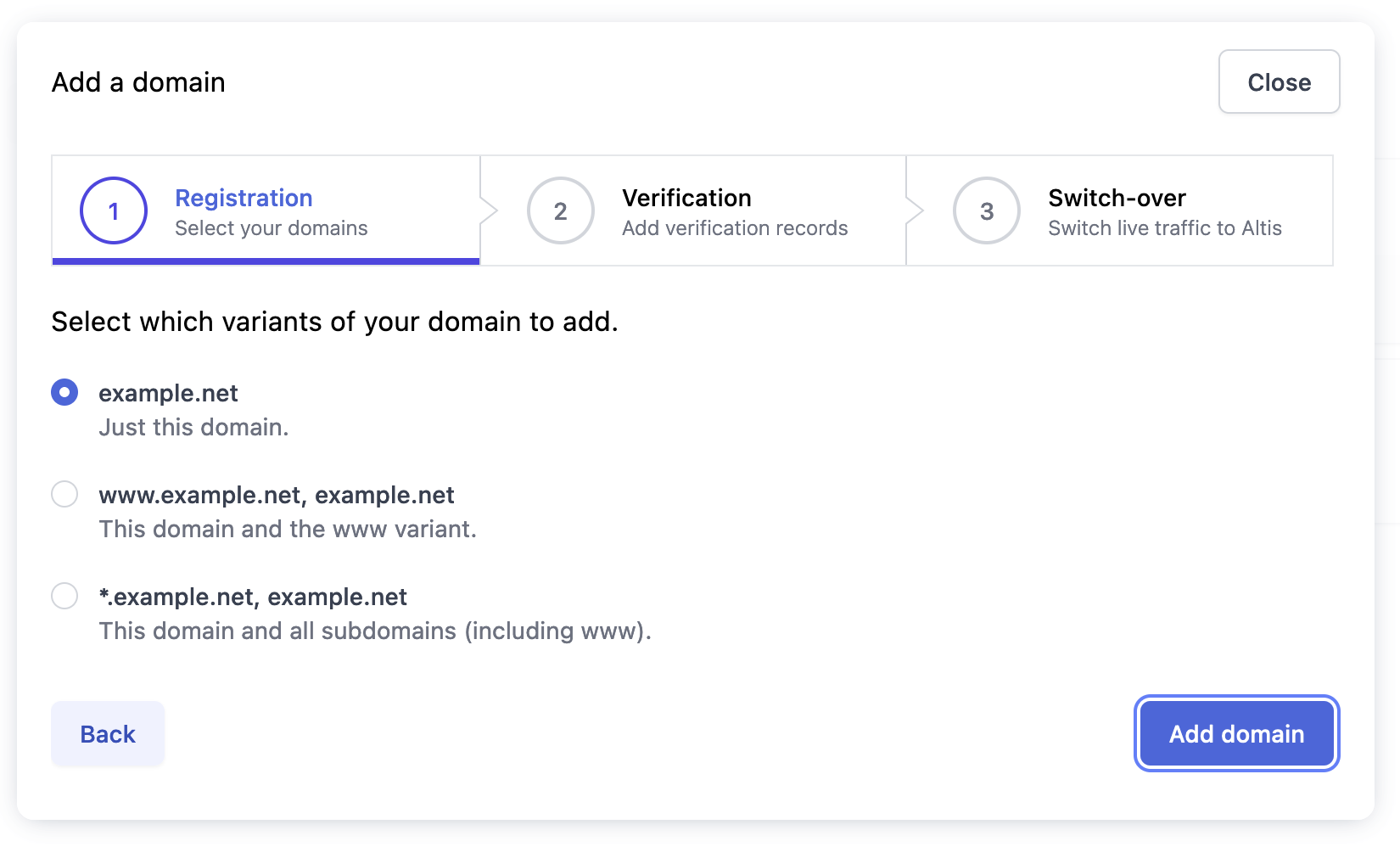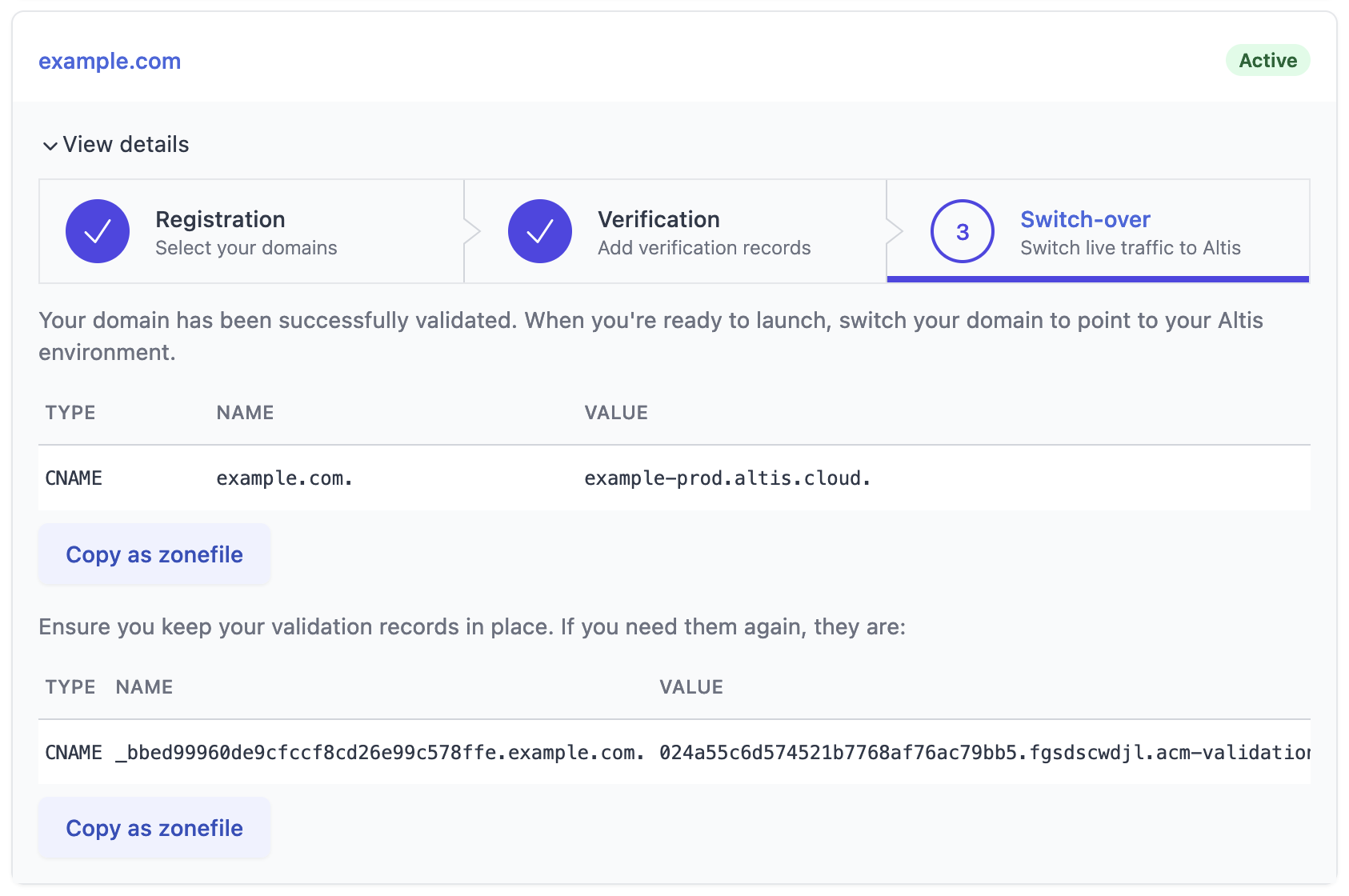DNS Configuration
Every Altis environment can have many domains configured, allowing seamless use of multisite across your network.
You can view your domain settings within the Altis Dashboard: select your environment's Settings page, then select the Domains setting. You'll be able to view all your existing domains here, as well as add new domains.

Adding a domain
Adding a new domain to Altis is a three step process.
- Register the domain with the CDN (registration)
- Add verification DNS records (verification)
- Add CNAME/ALIAS DNS records (switch-over)
Note that this is only necessary for adding new top-level domains which have not already been configured. Wildcard subdomain configuration will allow you to add new sub-sites without requiring DNS changes.
We recommend beginning this process at least a few weeks before your desired switch-over. User-visible changes to your site will only happen during the switch-over stage, and there will be no visible change to your site before this. See also Launching a Site on Altis
Registration (CDN configuration)
Before routing domains to Altis, you need to register the domain with the Altis infrastructure and CDN. This tells Altis that you want to associate the domain with the specific environment, and that the CDN should route requests to the environment.
(This is not the same as domain registration, and Altis does not act as your registrar. Altis does not currently offer the ability to purchase new domains.)
To start with the registration process, select the "Add new domain…" button.
Enter your base domain, excluding any www. or wildcards. If you are adding a subdomain, enter the full subdomain (e.g.
blog.example.com).

The next screen allows you to select which variants of the domain you want to add: either just this domain, with the www.
subdomain, or with a wildcard subdomain. We recommend selecting a wildcard subdomain to enable the full suite of multisite
capabilities for your domain, as this will avoid needing further manual steps when adding new subdomain sites in the future.

Once you've selected the domains you wish to add, click "Add domain" to register the domain with the CDN.
If you need to set up a more complex domain configuration (such as adding a wildcard to an already-registered domain), contact Altis support.
Verification
Altis automatically issues SSL certificates and configures the CDN to serve these certificates to users. When adding a new domain, verification will be required to ensure that you control the domain.
Once you register the domain in the Altis Dashboard, you'll receive DNS information for verification in the form of CNAME records.
These are provided by AWS, and reference acm-validations.aws.

You can visit the Domains settings page at any time to view these records again if needed.
These records must be added before the regular web CNAME records are added, allowing Altis to verify your domain ahead of switch-over. These will not conflict with existing records, and will have no user impact.
Note: Once the DNS records have been provided by Altis, please endeavour to add them within 72 hours, as they may time out after this, and will be marked as "Failed". If a domain is marked as Failed, contact Altis support to continue the process.
Switch-over
Once your domain has been verified, Altis will automatically update your environment to prepare it for switchover.
The final step is to route your custom domain to your Altis environment. This is done by adding a CNAME DNS record for your domain
or subdomains.
The value for your CNAME record will be displayed on the Domains settings page, as well as your verification records. (Make sure you don't delete the verification records, as they're needed for certificate renewal.)

After these DNS changes are put into place, your site will be served by Altis; this is called the "switch-over", as your site will "switch" from any existing host to Altis.
You can perform this step at any point after verification is complete when you're ready to switch your traffic.
Altis can only provide host names (fully qualified domain names) to be used in DNS records, not IP addresses, as servers are dynamically allocated based on traffic. Therefore, you must use CNAME, ANAME, or ALIAS records when configuring and managing your own DNS.
CNAME records
The simplest way to route your domain to Altis is to add CNAME records for any subdomains you wish to use. For example, you may wish
to use the www. subdomain for your main site.
The Dashboard will show you your project-specific domain to use in the CNAME record.
ALIAS/ANAME records
CNAME records are not supported on the domain apex (or "naked domain"); that is, the base domain without www., such
as example.com. This is a limitation of the DNS system and the CNAME specification. For apex domains, you must use either
ALIAS or ANAME records. These are newer 'virtual' record types and are both the same. One or the other may be supported by your
DNS provider.
Domain Apex
Commonly, you will want to implement a redirect from the domain apex to the subdomain, such as redirecting example.com
to www.example.com.
There are three ways to support this in Altis Cloud:
- Use ANAME/ALIAS records, as supported by your DNS provider
- Use your domain registrar to redirect the domain apex to the subdomain
- Use Altis managed name servers (see below)
Where possible, we recommend using ANAME/ALIAS records. These operate similarly to CNAME records, but can be used on the domain apex. However, not all registrars support these records, as they are relatively new.
You may also be able to use your registrar's redirection function. Many domain registrars support this service, and typically call it "web forwarding" or "web redirect".
Managed name servers
Altis can manage DNS records for you. This will require setting Altis as the authoritative name server for your domain, allowing us to manage verification and CNAME/ALIAS records on your behalf.
This has some advantages and disadvantages:
Advantages
- The domain apex can be used to either host your Altis properties or provide apex redirects such as
example.comtowww.example.com - Altis Cloud can manage and verify SSL certificates on your behalf
- Altis Cloud can validate email sending domains, and manage DKIM and SPF records on your behalf
Disadvantages
- Any external DNS updates you want to make will need to be handled via Altis Support requests